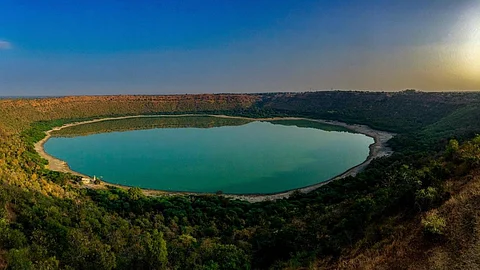
- Topics
- Feature
- Opportunities & Events
- About
- Hindi Portal
- Data
- Topics
- Feature
- Opportunities & Events
- About
- Hindi Portal
- Data

With two more wetlands added to the list of recognised sites of international importance under the treaty of Ramsar Convention, India now has 41 wetlands in the list, the highest in South Asia. The two sites that have been added are Lonar lake in Maharashtra, the only crater lake of the country, and Sur Sarovar, also known as Keetham lake, in Agra. The latter is the natural habitat of Sarus crane and spotted eagle. Ramsar status brings international attention to a wetland and also establishes the fact that a certain wetland meets international scientific and technical parameters. (Outlook India, The Times of India)
Under the National Disaster Relief Fund, the Centre has released Rs 4,381 crore to six states, with West Bengal getting the largest share. In view of cyclone Amphan, the state received central assistance to the tune of Rs 2,707.7 crore, in addition to the advanced central grant of Rs 1000 crore that was provided immediately after the devastation occurred. Apart from West Bengal, Centre has provided Rs 128.2 crore to Odisha for Cyclone Amphan, Rs 268.5 crore to Maharashtra for Cyclone Nisarga. For floods and landslides during southwest monsoon, Rs 577.8 crore were given to Karnataka, Rs 611.6 crore to Madhya Pradesh and Rs 87.8 crore to Sikkim. (The Times of India)
The National Board for Wildlife (NBWL) has recommended de-notification and diversion of more than 1,000 sq km of ‘protected areas’. The decision involves Hastinapur Wildlife Sanctuary in Uttar Pradesh, Mukundra National Park in Rajasthan and Bahu Conservation Reserve in Jammu district.
However, the Legal Initiative for Forest and Environment (LIFE) has called the move as the single largest denotification of ‘protected areas’ in recent times and flagged that the decision is in violation of the Supreme Court orders of 2000 which prohibits de-notification of any national park, forest and sanctuary.
(The Times of India)
The Chhattisgarh government and the Union Environment Ministry has allowed green clearance for a coal mine in Gare Palma area of Tamnar tehsil in Rajgarh district. The area has been put up for auction despite clear orders by the National Commission of Scheduled Tribes (NCST) to defer public hearings, and a study by Indian Council of Medical Research (ICMR) that has pointed to the adverse impacts of coal mining on health of tribals. Following the NCST order of 2018, the ICMR handed over the health report to the Environment Ministry in February 2020, which held nearby mining activities responsible for overall acute respiratory infections. (The Indian Express)
Following a petition filed by a Mandi resident, the Himachal Pradesh High Court has sought the Centre and Punjab government's stand to divest its control over Uhal River Hydro-Electric Project in the district and transfer it to Himachal Pradesh. Post the enactment of Punjab re-organisation Act, 1966, for creation of three states, the power project on the Uhal river in Himachal was handed over to Punjab in complete disregard to Himachal’s interest and depriving the state from income to the tune of Rs 100 crore every year from the Mandi power project. The court has directed all respondents to file their replies within four weeks. (The Economic Times)
This is a roundup of important policy matters from November 6 - 16, 2020. Also, read news this week.